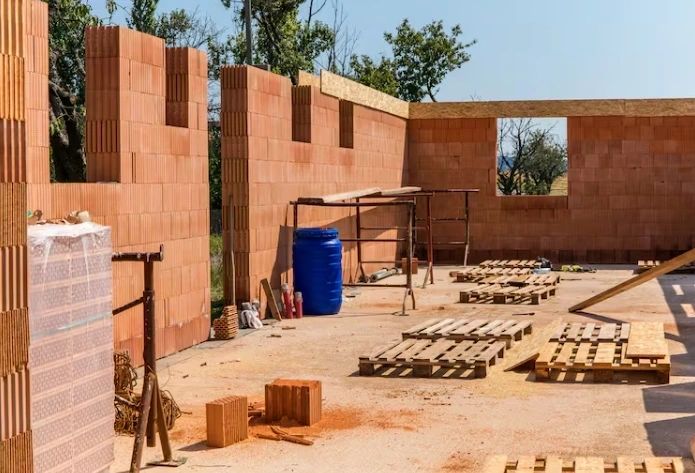BuySellBA
Administrator
Dollar rise: the impact on construction costs and mortgage lending - La Nacion Propiedades

Source:

 www.lanacion.com.ar
www.lanacion.com.ar
August 07, 2025
The recent rise of the dollar generated movements in the construction sector and in the mortgage loan market.
By Candela Contreras

The rise of the dollar directly impacts the cost of construction in dollars. Shutterstock
With the dollar hovering between bands (between $1,000 and $1,400) and having raised alarm among savers in recent days by positioning itself very close to its ceiling, the construction and real estate markets have also felt the impact . Last week, the dollar rose from $1,295 to $1,375 , and although it has begun to decline slightly in recent days (this Wednesday it opened at $1,350 at Banco Nación), it remains far from the floor.
In this context, where different industries are considering price increases for their products and services, real estate —a sector historically measured in dollars in Argentina— is not far behind. The rise in the dollar directly impacts construction costs in dollars , as many materials and services used in construction are priced or closely tied to the value of the US currency. This includes imported materials, as well as some local inputs that depend on imported components.
It is important to clarify that the cost of construction in Argentina has doubled in recent years , with particular emphasis on 2024: since October 2023 it has accumulated a rise of 126%, a figure that has set off alarm bells in the sector, especially considering that the sale value per square meter in the pit has risen only 23.82% on average, and that of used properties only 9.15%.
However, the dollar's behavior can also play in favor . When the currency rises , the cost of construction in dollars generally decreases, or at least, the rise in dollar prices for construction materials moderates . This is because most construction materials, especially imported ones, are priced in dollars or indexed to the US currency. If the dollar rises , it takes fewer dollars to buy the same amount of materials than before, making construction less expensive in foreign currency terms.
"Like any partially dollarized sector, when the currency depreciates, costs increase in pesos , but they decrease in dollars . If we calculate the cost per square meter in dollars in August, it will likely be lower than in June," Federico Machado, an economist at the National Economic Policy Observatory (OPEN), told LA NACION.

If the dollar increases, fewer dollars are needed to buy the same amount of materials as before.Shutterstock
But not everything is so linear . According to the economist, the volatility generated by free floating within bands " affects private sector projects and generates higher hedging costs ." "Argentina is still far from having a strong currency like other countries—like Brazil—for the band system to work. If one believes in the solidity of the scheme, it makes sense to borrow in dollars and invest in pesos when we're close to the upper band—as we are now—and to do the opposite when it's close to the bottom ," he adds.
From the developers ' perspective , the rise of the dollar could represent an opportunity , but only if it isn't immediately passed on to prices . "In pure mathematics, if the dollar rises and prices in pesos don't adjust at the same rate, everything becomes cheaper in dollars," explains Damián Tabakman, president of the Chamber of Urban Developers (CEDU).
"What happened in recent months was that prices in dollars didn't rise, and profitability was destroyed. With this rise in the dollar, if costs in pesos don't rise equally, there could be a recovery . But that's not happening today," he maintains.
Tabakman clarifies that if the dollar's rise had been sustained or accelerated, the impact would have been greater. "This week it calmed down a bit. If the exchange rate holds steady, it could be good news for the developer's account. But if it quickly translates into inflation, that opportunity vanishes. For now, it seems under control," he says.
Machado agrees, " The key is to sustain the decline in inflation , because if it consolidates, real interest rates will fall and we will have credit growth that could have a very positive impact on the sector."
According to Issel Kiperszmid, director at Dypsa International, the real impact on construction costs in dollars was moderate. “There was probably an improvement of around 8% in dollar terms, not because of a drop in prices, but because the dollar rose faster than costs in pesos . In many cases, suppliers have partially dollarized costs, but at this point, a widespread markup has not yet been seen,” he explains.
"It's actually more of a recovery from what happened recently with rising costs, something that was very high."
Banks finance their portfolios with short-term deposits (generally less than 90 days), while UVA loans extend to 20 or even 30 years . This difference creates tension: "You can't finance for 30 years if your deposits are for 30 days," several specialists analyze.
This gap creates a liquidity problem : every time loans increase, banks need to borrow more expensively to maintain their supply. The system's natural response is to raise the Annual Nominal Rate (ANR) to moderate access.
"This has a particular impact on buyers who were looking to finance their mortgage. With bank interest rates already exceeding 10%, it's very difficult for a family to afford a down payment . And banks are also more restrictive," says Kipersmid.
The impact of the dollar's rise is not as noticeable for buyers who already have dollars and are looking for finished properties, as transactions in this segment are negotiated in the same currency. However, for those who rely on credit or were about to initiate a transaction in pesos, the effect is significant. "Today, those who have dollars continue to buy, but those who needed financing are on hold," adds Kipersmid.
www.buysellba.com
Source:
Suba del dólar: el impacto en los costos de construcción y en el crédito hipotecario
La reciente suba del dólar generó movimientos en el sector de la construcción y en el mercado de los créditos hipotecarios
August 07, 2025
The recent rise of the dollar generated movements in the construction sector and in the mortgage loan market.
By Candela Contreras

The rise of the dollar directly impacts the cost of construction in dollars. Shutterstock
With the dollar hovering between bands (between $1,000 and $1,400) and having raised alarm among savers in recent days by positioning itself very close to its ceiling, the construction and real estate markets have also felt the impact . Last week, the dollar rose from $1,295 to $1,375 , and although it has begun to decline slightly in recent days (this Wednesday it opened at $1,350 at Banco Nación), it remains far from the floor.
In this context, where different industries are considering price increases for their products and services, real estate —a sector historically measured in dollars in Argentina— is not far behind. The rise in the dollar directly impacts construction costs in dollars , as many materials and services used in construction are priced or closely tied to the value of the US currency. This includes imported materials, as well as some local inputs that depend on imported components.
It is important to clarify that the cost of construction in Argentina has doubled in recent years , with particular emphasis on 2024: since October 2023 it has accumulated a rise of 126%, a figure that has set off alarm bells in the sector, especially considering that the sale value per square meter in the pit has risen only 23.82% on average, and that of used properties only 9.15%.
However, the dollar's behavior can also play in favor . When the currency rises , the cost of construction in dollars generally decreases, or at least, the rise in dollar prices for construction materials moderates . This is because most construction materials, especially imported ones, are priced in dollars or indexed to the US currency. If the dollar rises , it takes fewer dollars to buy the same amount of materials than before, making construction less expensive in foreign currency terms.
"Like any partially dollarized sector, when the currency depreciates, costs increase in pesos , but they decrease in dollars . If we calculate the cost per square meter in dollars in August, it will likely be lower than in June," Federico Machado, an economist at the National Economic Policy Observatory (OPEN), told LA NACION.

If the dollar increases, fewer dollars are needed to buy the same amount of materials as before.Shutterstock
But not everything is so linear . According to the economist, the volatility generated by free floating within bands " affects private sector projects and generates higher hedging costs ." "Argentina is still far from having a strong currency like other countries—like Brazil—for the band system to work. If one believes in the solidity of the scheme, it makes sense to borrow in dollars and invest in pesos when we're close to the upper band—as we are now—and to do the opposite when it's close to the bottom ," he adds.
From the developers ' perspective , the rise of the dollar could represent an opportunity , but only if it isn't immediately passed on to prices . "In pure mathematics, if the dollar rises and prices in pesos don't adjust at the same rate, everything becomes cheaper in dollars," explains Damián Tabakman, president of the Chamber of Urban Developers (CEDU).
"What happened in recent months was that prices in dollars didn't rise, and profitability was destroyed. With this rise in the dollar, if costs in pesos don't rise equally, there could be a recovery . But that's not happening today," he maintains.
Tabakman clarifies that if the dollar's rise had been sustained or accelerated, the impact would have been greater. "This week it calmed down a bit. If the exchange rate holds steady, it could be good news for the developer's account. But if it quickly translates into inflation, that opportunity vanishes. For now, it seems under control," he says.
Machado agrees, " The key is to sustain the decline in inflation , because if it consolidates, real interest rates will fall and we will have credit growth that could have a very positive impact on the sector."
According to Issel Kiperszmid, director at Dypsa International, the real impact on construction costs in dollars was moderate. “There was probably an improvement of around 8% in dollar terms, not because of a drop in prices, but because the dollar rose faster than costs in pesos . In many cases, suppliers have partially dollarized costs, but at this point, a widespread markup has not yet been seen,” he explains.
"It's actually more of a recovery from what happened recently with rising costs, something that was very high."
Issel Kiperszmid
He also warns that demand for inputs has remained relatively stable and that developers remain cautious. "The gap between costs in pesos and prices in dollars continues to be closely monitored. There is a very active microeconomic situation that doesn't always respond immediately to macroeconomic movements," he concludes.Mortgage credit: affected by exchange rate volatility
As the dollar approached the band's ceiling, another side effect began to be felt strongly in the market: the slowdown in mortgage lending . Recent decisions by the Central Bank, such as the increase in reserve requirements for banks, generated less liquidity in the financial system , leading to further rate hikes and greater caution in lending, as the amount of money in circulation decreases.Banks finance their portfolios with short-term deposits (generally less than 90 days), while UVA loans extend to 20 or even 30 years . This difference creates tension: "You can't finance for 30 years if your deposits are for 30 days," several specialists analyze.
This gap creates a liquidity problem : every time loans increase, banks need to borrow more expensively to maintain their supply. The system's natural response is to raise the Annual Nominal Rate (ANR) to moderate access.
"This has a particular impact on buyers who were looking to finance their mortgage. With bank interest rates already exceeding 10%, it's very difficult for a family to afford a down payment . And banks are also more restrictive," says Kipersmid.
The impact of the dollar's rise is not as noticeable for buyers who already have dollars and are looking for finished properties, as transactions in this segment are negotiated in the same currency. However, for those who rely on credit or were about to initiate a transaction in pesos, the effect is significant. "Today, those who have dollars continue to buy, but those who needed financing are on hold," adds Kipersmid.
www.buysellba.com

